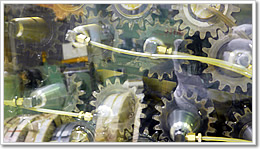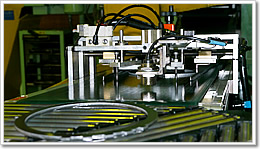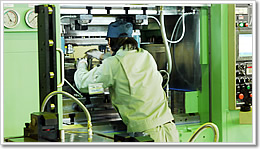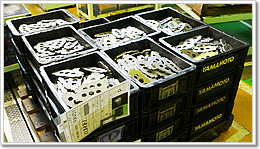HOME Technology
Technology Development of precise a Die & mold technology
Development of precise a Die & mold technology
Our company's die technology began with progressive dies
 This company started out as a stamping press tool and die manufacturer. Die technology fit very well to industrious Japanese with dexterous finger tips, and we were proud of the superhuman nature of this craftsman art. As mentioned earlier, the Japanese industry rebounded from the ashes of World War II with speed regarded as no less than a miracle, and one by one the world's markets were acquired. It is stamping tool and dies that constantly supported this growth.
This company started out as a stamping press tool and die manufacturer. Die technology fit very well to industrious Japanese with dexterous finger tips, and we were proud of the superhuman nature of this craftsman art. As mentioned earlier, the Japanese industry rebounded from the ashes of World War II with speed regarded as no less than a miracle, and one by one the world's markets were acquired. It is stamping tool and dies that constantly supported this growth.
Our company's die technology began with progressive dies, and we began to focus on extrusion and bending actions inside the die as we fine-tuned technology to meet customers' needs no matter how complicated the parts required. Deep extrusions and side wall openings require difficult and complicated extrusion fabrication. Of course the maintenance of such dies and other inconveniences arise and require more and more technology.
Development of transfer dies.
 Next, we challenged the development of transfer dies which utilize progressive die technology. Combining separate dies that perform deep extrusion and bending, transfer dies have the merits of easy maintenance and good material yield.
Next, we challenged the development of transfer dies which utilize progressive die technology. Combining separate dies that perform deep extrusion and bending, transfer dies have the merits of easy maintenance and good material yield.
During bending of highly elastic materials such as stainless steel and bronze, stamping tool design methodologies must account for the spring-back characteristics. We then hit upon multiforming which provides excellent control of this spring-back characteristic. Effectively, this separates each stage of the progressive die and mounts them on one machine. In this way, we are always going through trial and error to determine the right dies necessary to fabricate parts required by customers.
Challenge at Fine-Blanking worling.
 Finally, this brings us to this company's main fabrication technology, fine blanking (precision punching fabrication). This superior technology includes a "shaving action" that leaves a clean finish on the cross section of the material. However, the extremely complex theory of stamping and die fabrication and the high cost of fine blanking press machines kept small-to-mid sized companies out of the business for quite some time. Actually, we challenged this technology once in the 1970s but were setback by the equipment cost and difficulty meeting the specified performance.
Finally, this brings us to this company's main fabrication technology, fine blanking (precision punching fabrication). This superior technology includes a "shaving action" that leaves a clean finish on the cross section of the material. However, the extremely complex theory of stamping and die fabrication and the high cost of fine blanking press machines kept small-to-mid sized companies out of the business for quite some time. Actually, we challenged this technology once in the 1970s but were setback by the equipment cost and difficulty meeting the specified performance.
We continued to acquire little by little the die technology and stamping technology of fine blanking. After much struggle, we launched a full scale attempt with this technology in 1979, and by continuing year by year to increase the number of machines despite their high cost, this technology now represents 80% of parts fabricated.
Our company's stance for challenging technology is to try a unique approach.
 Our company's stance for challenging technology is to try a unique approach. When purchasing press machines and die fabrication machines, we ask the machine manufacturer to give us technical instruction on the theory of production and die design.
Our company's stance for challenging technology is to try a unique approach. When purchasing press machines and die fabrication machines, we ask the machine manufacturer to give us technical instruction on the theory of production and die design.
The first tool is made by the machine manufacturer and tried out by mounting on an actual machine. Next, we accumulate technology while receiving instruction on die design until our company can build dies by ourselves. This is the method our company followed to firmly establish know-how for transfer dies, multiforming dies, and fine blanking tools.
At first leaning heavily on the cooperation of others, we met the challenge of training our company's engineers and developing technology. Today, we are testing our fine blanking capabilities in the American market, and thanks to your support, we are steadily prospering. I am positive that tool and die technology has been the secret behind our company's growth.
